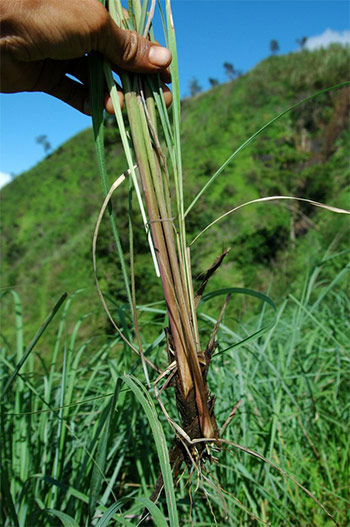Citronella Essential Oil
Cymbopogon nardus / Cymbopogon winterianus

Description
Citronella is an aromatic, perennial grass that is cultivated primarily in Asia.
Citronella Essential Oil is most widely known for its ability to deter mosquitos and other insects. Because the aroma is so widely associated with insect repellent products, Citronella Oil is often ignored for its other beneficial uses (refer to the Citronella Essential Oil Uses section below).
Citronella Essential Oil is abundant in citronellal (aldehyde) and in geraniol and citronellol (monoterpenols). The specific composition can vary due to several factors including the region that its grown.

Aromatically, Citronella Oil possesses a citrusy, slightly fruity, fresh and sweet aroma that blends well with essential oils in the citrus, floral, herbaceous and wood families.
Citronella Essential Oil Benefits and Uses
- Muscular Aches
- Infectious Skin Conditions
- Fevers
- Heat Rash
- Excessive Perspiration
- Fungal Infections
- Fatigue
- Insect Bites
- Insect Deterrent
Source: Valerie Ann Worwood, The Complete Book of Essential Oils and Aromatherapy, 25th Anniversary Edition (Novato, CA: New World Library, 2016, 581.
- Arthritic And Muscular Pain
- Neuralgia
- Fatigue
- Nervous Exhaustion
- Colds/Flu
- Minor Infections
- Insect Repellent
- Excessive Perspiration
- Oily Skin
Source: Salvatore Battaglia, The Complete Guide to Aromatherapy (Australia: The Perfect Potion, 2003), 187.
Botanical Name
Cymbopogon nardus / Cymbopogon winterianus
Plant Family
Common Method of Extraction
Steam Distilled
Plant Part Typically Used
Color
Clear
Consistency
Thin
Perfumery Note
Top
Strength of Initial Aroma
Medium
Aromatic Description
Citronella Essential Oil smells citrusy, slightly fruity, fresh and sweet.
Major Constituents
- Citronellal
- Geraniol
- (-)-Citronellol
- (-)-Limonene
- (E)-Methyl Isoeugenol
- Champhene
- Citronellyl acetate
See Essential Oil Safety for a more complete list of typical constituents.
Source: R.O.B. Wijesekera, The Chemical Composition and Analysis of Citronella Oil. (J. Natl. Sci. Council (Sri Lanka) 1, 1973), 67-81. K. Bruns, E. Heinrich, I. Pagel. Citronellaol: Untersuchung von Handels- und Hybridolen Verschiedener Provinienz. (In: Kubeczka, Vorkommen und Analytic atherischer Ole, Band 2. Thieme Verlag, Stuttgart). J.T. Carlin, S. Kramer, C.T. Ho. Comparison of Commercial Citronella Oils from Various Origins. In: B.M. Lawrence, B.D. Mookerjee, B.J. Willis, Flavor and Frances: a World Perspective (Amsterdam: Elsevier Science, 1988), 495-504. B.M. Lawrence, Essential Oils 1981-1987 (Wheaton: Allured Publishing, 1989), 31. L. Zhu, Y. Li, B. Li, et al. Aromatic Plants and Essential Constituents. (South China Institute of Botany, HK, 1993). Sources cited in Robert Tisserand and Rodney Young, Essential Oil Safety (Second Edition. United Kingdom: Churchill Livingstone Elsevier, 2014), 251.
Citronella Essential Oil Safety Information
Tisserand and Young indicate that there is a risk of drug interaction when using Citronella Oil. They recommend a dermal maximum of 18.2%. Reading Tisserand and Young's full profile is recommended. [Robert Tisserand and Rodney Young, Essential Oil Safety (Second Edition. United Kingdom: Churchill Livingstone Elsevier, 2014), 251.]
General Safety Information
Do not take any oils internally and do not apply undiluted essential oils, absolutes, CO2s or other concentrated essences onto the skin without advanced essential oil knowledge or consultation from a qualified aromatherapy practitioner. For general dilution information, read AromaWeb's Guide to Diluting Essential Oils. If you are pregnant, epileptic, have liver damage, have cancer, or have any other medical problem, use oils only under the proper guidance of a qualified aromatherapy practitioner. Use extreme caution when using oils with children and be sure to first read the recommended dilution ratios for children. Consult a qualified aromatherapy practitioner before using oils with children, the elderly, if you have medical issues or are taking medications. Before using this or any essential oil, carefully read AromaWeb's Essential Oil Safety Information page. For in-depth information on oil safety issues, read Essential Oil Safety by Robert Tisserand and Rodney Young.
Shelf Life
Important Information About the Profiles
The essential oil information provided on AromaWeb is intended for basic educational purposes only. The references to safety information, test results, constituents and percentages is generalized information. Essential oils can vary greatly in composition. The data is not necessary complete and is not guaranteed to be accurate. The essential oil photos are intended to represent the typical and approximate color of each essential oil. However, essential oil composition and color can vary based on harvesting, distillation, age of the essential oil and other factors. Profiles for several CO2 Extracts and absolutes are included within the directory, and are denoted as such.
